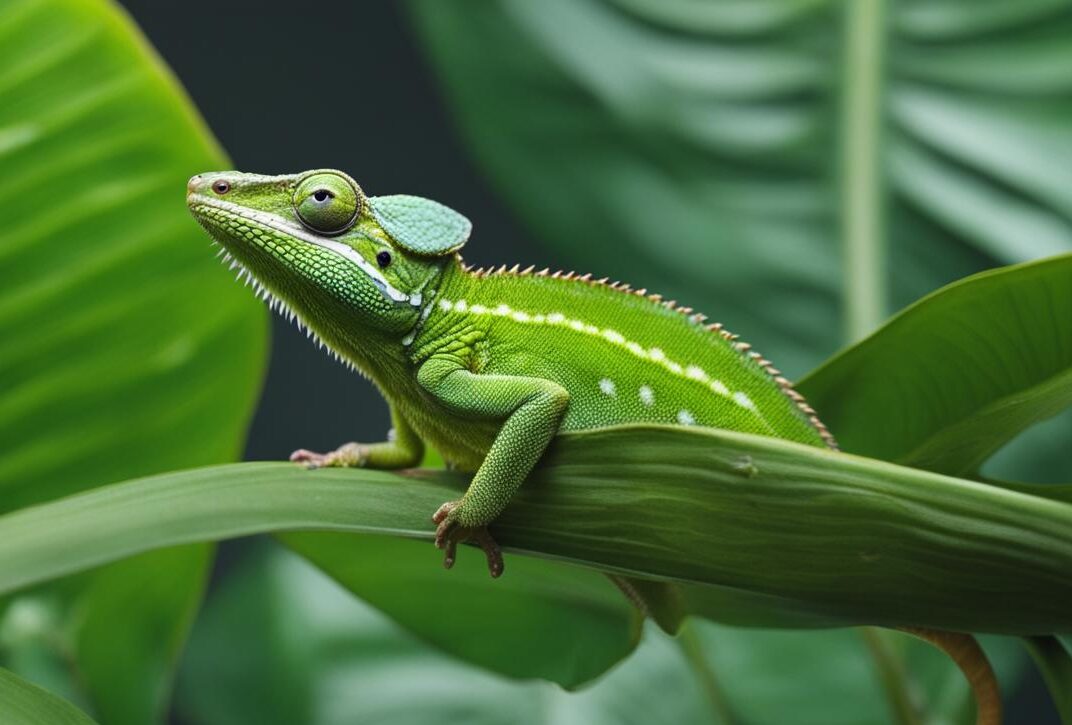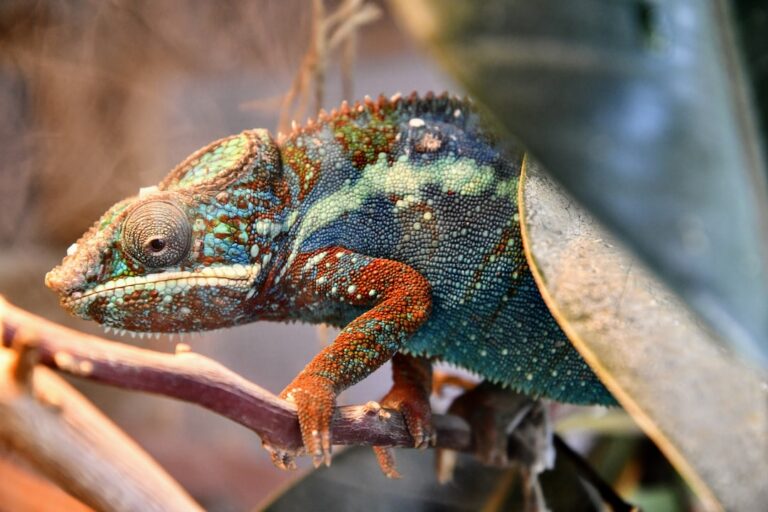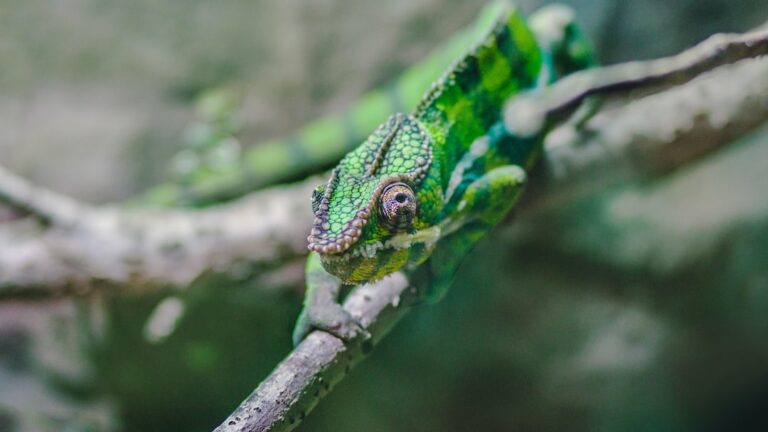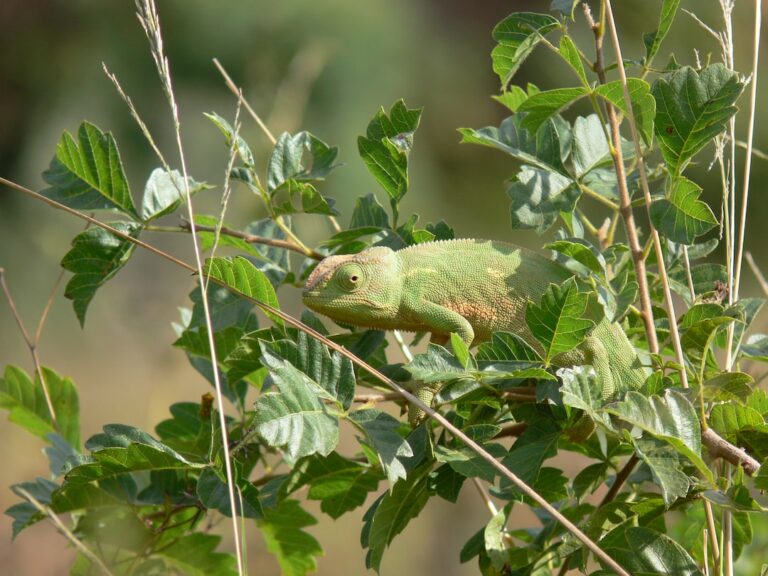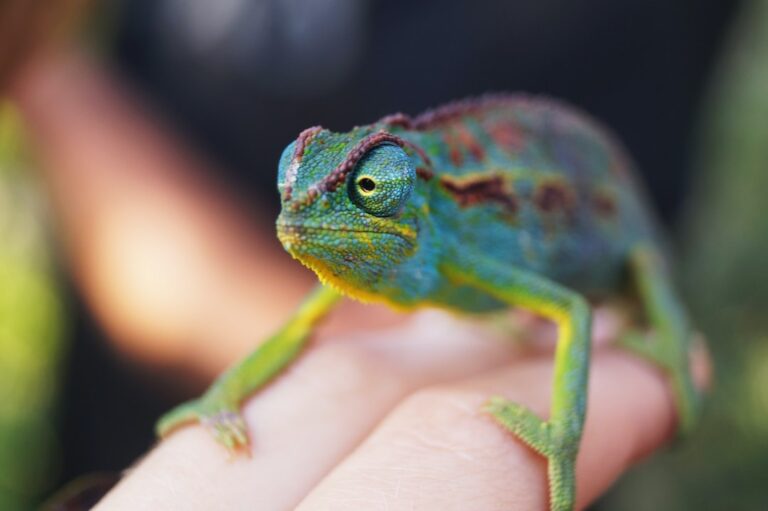Discover the Smallest Chameleon Pets for Your Home Oasis
Chameleons are fascinating reptiles known for their ability to change colors. If you’re interested in keeping a chameleon as a pet, you may want to consider the smallest chameleon species available. These tiny chameleons, such as the Pygmy Chameleon (Brookesia spp.), are native to Madagascar and are some of the smallest reptiles in the world.
Table of Contents
Key Takeaways
- Small chameleons, like the Pygmy Chameleon, are perfect for home enthusiasts due to their compact size.
- Chameleons are known for their unique ability to change colors.
- The Brookesia genus includes several species of small chameleons.
- Creating a suitable habitat is essential for the well-being of small chameleons.
- Conservation efforts are crucial to protect critically endangered chameleon species.
The Smallest Chameleon Species
When it comes to tiny reptiles, the Brookesia genus offers some of the smallest chameleon species in the world. One notable species is the Brookesia nana, also known as the nano-chameleon. This charming creature measures just about 10 inches in length, making it a true miniature marvel. But the nano-chameleon is not alone in its small stature. The Brookesia micra, with a maximum length of approximately 4 inches, is equally fascinating.
These nano-chameleons have evolved unique adaptations that enable them to thrive in the leaf litter of the rainforest floor. Their small size and intricate body features allow them to blend into their surroundings, making them difficult to spot. Despite their diminutive stature, they possess all the distinctive characteristics and behaviors of their larger chameleon relatives.
With their vibrant colors and intricate patterns, these small chameleons capture the imagination of reptile enthusiasts around the world. Their size makes them captivating pets to observe and care for, as they display their unique color-changing abilities. The nano-chameleon and its small chameleon counterparts offer a world of exotic charm within their tiny frames.
Table: A Comparison of Brookesia Chameleon Species
| Chameleon Species | Length |
|---|---|
| Brookesia nana (nano-chameleon) | Approximately 10 inches |
| Brookesia micra | Approximately 4 inches |
Table: A comparison of the sizes of the Brookesia nana (nano-chameleon) and Brookesia micra, showcasing their remarkable smallness.
Ideal Enclosures for Small Chameleons
When creating an enclosure for small chameleons like the Brookesia species, it’s important to consider their specific habitat requirements. These tiny reptiles thrive in enclosures that mimic their natural environment, with a focus on providing ample leaf litter and ground-dwelling spaces.
A small enclosure with the appropriate size and ventilation is crucial for the well-being of small chameleons. Due to their small size, a compact enclosure can create a comfortable and secure environment. It’s recommended to opt for materials that are easy to clean and maintain, such as glass or plastic terrariums.
Live plants make an excellent addition to the enclosure, not only for aesthetic purposes but also to provide hiding spots and ensure humidity regulation. Some suitable plant species include pothos, ficus, and spider plants. These plants also contribute to the overall aesthetics of the enclosure, creating a beautiful and natural setting for the chameleons.
Table: Recommended Enclosure Set-up for Small Chameleons
| Enclosure Type | Size (Length x Width x Height) | Ventilation | Substrate | Live Plants |
|---|---|---|---|---|
| Glass Terrarium | 12″ x 12″ x 18″ | Mesh top for adequate airflow | Leaf litter and soil mixture | Pothos, ficus, spider plants |
| Plastic Terrarium | 16″ x 16″ x 16″ | Ventilation holes on the sides | Leaf litter and soil mixture | Pothos, ficus, spider plants |
| Glass Terrarium | 18″ x 18″ x 24″ | Mesh top for adequate airflow | Leaf litter and soil mixture | Pothos, ficus, spider plants |
By creating a suitable enclosure with the right size, ventilation, substrate, and live plants, chameleon owners can ensure that their small pets have a comfortable and stimulating habitat that closely resembles their natural environment. This will contribute to the overall well-being and happiness of these fascinating creatures.
Understanding the Care Needs of Small Chameleons
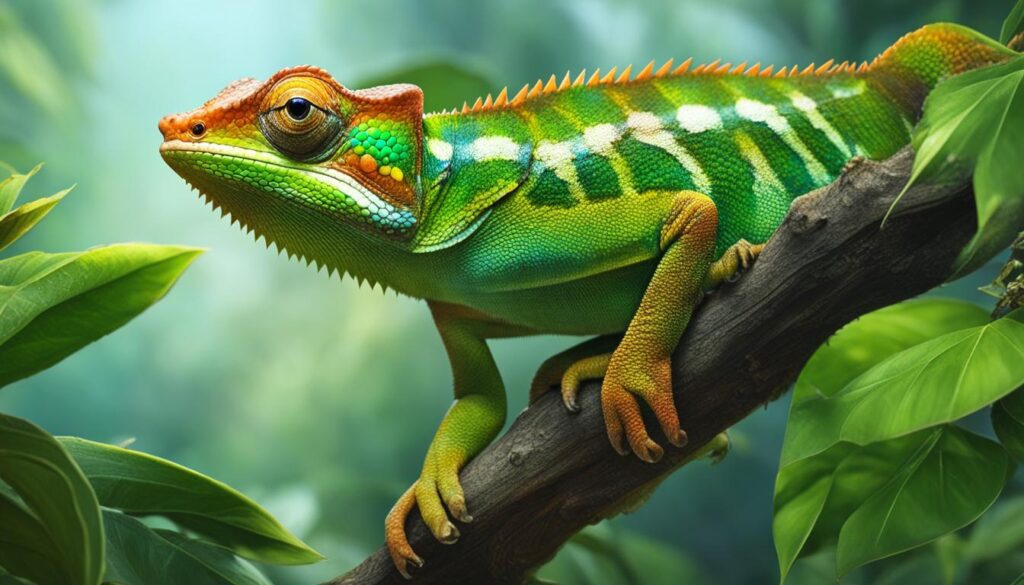
When it comes to caring for small chameleons, it’s important to understand their specific needs. These delicate creatures require high humidity levels to thrive. Providing a well-misted environment or using automatic misting systems can help maintain the necessary humidity for their well-being. It’s crucial to monitor and regulate humidity levels regularly to ensure their health and prevent respiratory issues.
In terms of diet, small chameleons mainly feed on small insects like fruit flies and pinhead crickets. These tiny creatures have small statures, and their diets reflect their size. Offering a varied and appropriate diet is essential to meet their nutritional needs. Feeding live insects that are appropriately sized for their mouths is crucial for their digestion and overall health.
Due to their small stature, small chameleons are more fragile compared to their larger counterparts. They require gentle handling and care to avoid any injuries. It’s important to avoid excessive stress and provide a secure and safe environment for their well-being.
Overall, understanding the care needs of small chameleons, including providing high humidity, a suitable diet, and delicate handling, is essential for their health and happiness as pets.
Key Care Needs of Small Chameleons:
- High Humidity: Maintain proper humidity levels through misting or automatic misting systems.
- Appropriate Diet: Feed small chameleons a varied diet consisting of small insects like fruit flies and pinhead crickets.
- Delicate Handling: Handle small chameleons gently to avoid injuries and minimize stress.
Expert Insights:
“Small chameleons require careful attention to their habitat and care. Providing high humidity and a suitable diet are crucial for their well-being. It’s important to handle them delicately and create a secure environment for their optimal health.” – Reptile Care Expert
The Exotic Charm of Small Chameleons
One of the most captivating aspects of small chameleons is their ability to change colors. These tiny reptiles possess a remarkable skill that adds to their exotic charm. Through a complex process, chameleons can alter the pigments in their skin cells, allowing them to display a range of vibrant hues. This incredible color-changing ability serves multiple purposes in their natural habitat, including camouflage, communication, and temperature regulation.
The intricate color patterns and transformations of small chameleons are a visual delight for reptile enthusiasts. As these little creatures navigate their surroundings, their skin adapts to match the colors and patterns of their environment. Witnessing the mesmerizing display of hues as they blend seamlessly with their surroundings is truly a sight to behold.
Additionally, small chameleons exhibit unique body features that contribute to their exotic allure. These delicate reptiles have a small stature, making them even more endearing. Their intricate scales, bulging eyes, and slender limbs further enhance their enchanting appearance. The combination of their size, colors, and distinct physical characteristics makes small chameleons a popular choice for individuals seeking a unique and visually stunning pet.
The Transformative Power of Color
Chameleons change colors through the use of specialized cells in their skin called chromatophores. These cells contain pigments that can expand or contract, allowing the chameleon to control the light wavelengths it reflects. By altering the distribution of these pigments, chameleons can create an incredible range of colors and patterns. Their ability to change color also extends to their moods and social interactions, making it a fascinating aspect of their behavior.
The exotic charm of small chameleons lies in their captivating ability to change colors, their unique physical features, and the mesmerizing display of hues they exhibit. These endearing reptiles are sure to enchant any reptile enthusiast and add a touch of exotic beauty to any home oasis.
| Key Features | Exotic Charm |
|---|---|
| Color-changing ability | Their vibrant hues and mesmerizing color transformations |
| Unique body features | Delicate size, intricate scales, bulging eyes, and slender limbs |
| Mood and social influence | Color changes that reflect their emotions and communication |
Small Chameleons as Great Pets
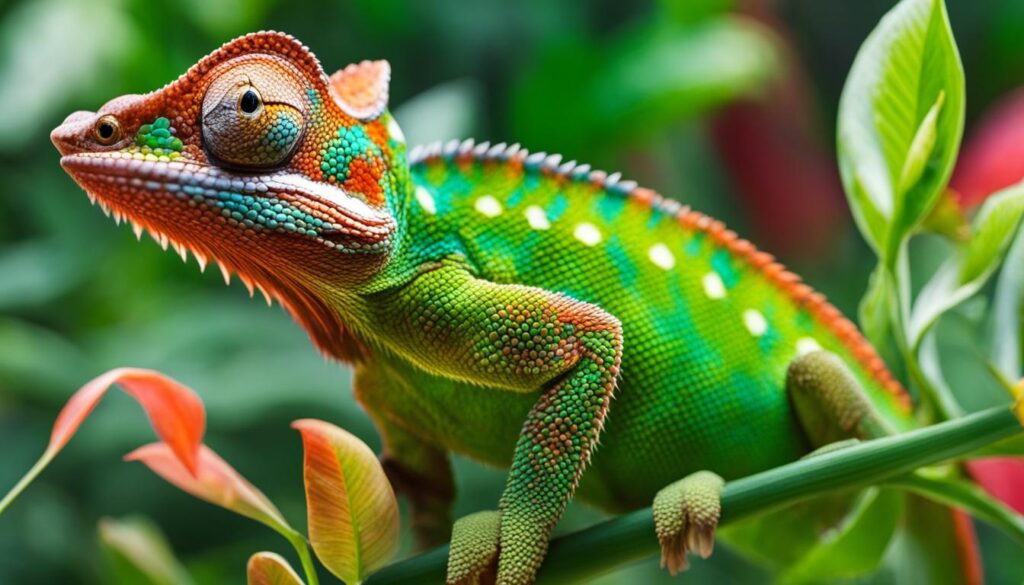
Despite their small size, small chameleons can make great pets for experienced reptile keepers. These tiny creatures may be barely the size of your thumb, but they exhibit all the behaviors and characteristics of their larger counterparts. With their exotic charm and unique care needs, small chameleons can provide a rewarding and fascinating experience for reptile enthusiasts.
Small chameleons, such as the Brookesia species, are fully grown and display the same color-changing abilities as their larger relatives. Their small stature makes them less intimidating, and their delicate appearance adds to their appeal as pets. While they may require more attention to detail in terms of environmental conditions and diet, their captivating presence and gentle nature make them a joy to observe and care for.
To ensure the well-being of small chameleons, it’s important to provide them with the right habitat. A small, well-ventilated enclosure with live plants and a substrate of leaf litter and soil can create a suitable environment for these tiny reptiles. Maintaining high humidity levels through misting or automatic misting systems is crucial for their health and proper shedding. Additionally, offering a varied diet of small insects like fruit flies and pinhead crickets will ensure they receive the necessary nutrition.
When considering small chameleons as pets, it’s essential to have prior experience with reptile care. They require attention to detail and a solid understanding of their specific needs. However, for those who are knowledgeable and committed to providing a suitable environment, small chameleons can be delightful companions that bring a touch of exotic beauty into your home.
Conservation of Small Chameleon Species
Many small chameleon species, including those in the Brookesia genus, are critically endangered due to habitat loss. The destruction of their natural habitats, primarily through deforestation and urbanization, has led to a significant decline in their populations. These unique reptiles, with their remarkable ability to adapt and thrive in their native environments, are now facing the threat of extinction.
The conservation of small chameleon species is of utmost importance to ensure the preservation of these incredible creatures for future generations. Efforts are being made by organizations such as the International Union for Conservation of Nature (IUCN) to protect and restore their habitats, as well as raise awareness about the importance of their conservation. These organizations work closely with local communities, governments, and other stakeholders to implement strategies to mitigate habitat loss and support the recovery of small chameleon populations.
The critically endangered status of small chameleon species serves as a reminder of the urgent need to prioritize the conservation of nature. By taking action to protect these small creatures and their habitats, we can contribute to the overall well-being of our planet’s biodiversity. Every effort counts in the fight against habitat loss, and individuals can make a difference by supporting conservation initiatives, advocating for responsible land use practices, and spreading awareness about the importance of protecting these unique reptiles.
Table: Critically Endangered Small Chameleon Species
| Species | Scientific Name | Status |
|---|---|---|
| Pygmy Chameleon | Brookesia spp. | Critically Endangered |
| Nano-Chameleon | Brookesia nana | Critically Endangered |
| Madagascar Leaf Chameleon | Brookesia superciliaris | Critically Endangered |
Table: Critically endangered small chameleon species and their current conservation status.
It is our responsibility to protect the biodiversity of our planet, and small chameleon species are an important part of that biodiversity. By supporting conservation efforts and promoting sustainable practices, we can contribute to the preservation of these remarkable creatures and the ecosystems they inhabit.
Expert Insights on Small Chameleon Care
When it comes to caring for small chameleons, herpetologists and reptile experts have valuable insights to share. These professionals offer guidance on essential aspects such as UVB lighting, humidity levels, and insect diets.
A herpetologist’s expertise is crucial for the well-being of your small chameleon. They recommend providing UVB lighting to ensure proper vitamin D3 synthesis, as these reptiles require exposure to UVB rays for optimal health. This can be achieved through the use of specialized UVB bulbs or fluorescent tubes, placed within the chameleon’s enclosure.
Another important aspect of small chameleon care is maintaining high humidity levels. These reptiles thrive in environments with humidity levels of around 50-70%. To achieve this, misting the enclosure several times a day or using an automatic misting system can help create the ideal habitat for your chameleon.
Lastly, a varied insect diet is essential for the health and vitality of small chameleons. Fruit flies, pinhead crickets, and other small insects are suitable options for feeding these tiny reptiles. It is important to ensure that the insects are gut-loaded with nutritious food before offering them to your chameleon.
By following the expert advice of herpetologists and reptile professionals, chameleon owners can provide the best care for their small pets. This knowledge and expertise contribute to the overall well-being and happiness of these fascinating reptiles.
Finding the Perfect Small Chameleon
Chameleon owners are always seeking new and unique species to add to their collections. With ongoing scientific research and discoveries, there is a growing interest in keeping small chameleons as pets. These incredibly tiny reptiles offer reptile enthusiasts a chance to observe and care for some of the smallest chameleon species on the planet.
When looking for the perfect small chameleon, it’s important to do thorough research and find reputable breeders. Captive-bred chameleons are generally healthier and better adapted to living in captivity. Reputable breeders prioritize the well-being of their animals and adhere to responsible breeding practices.
As you embark on your search for a small chameleon, consider the specific care needs and requirements of the species you’re interested in. Different species may have varying dietary preferences, enclosure requirements, and environmental conditions. By understanding these factors, you can provide the best possible care for your new pet.
| Factors to Consider when Finding the Perfect Small Chameleon | Details |
|---|---|
| Diet | Research the insect diet the species requires. Some small chameleons may have specific preferences for certain types of insects. |
| Enclosure Size | Consider the size and space requirements of the species. Ensure that you have an appropriately sized enclosure for your future pet. |
| Temperature and Humidity | Small chameleons have specific temperature and humidity needs. Research the ideal range for the species you’re interested in and ensure you can provide the appropriate conditions. |
| Handling and Interaction | Some small chameleon species may be more tolerant of handling than others. Consider your preferences and expectations for interaction with your pet. |
By taking the time to find the perfect small chameleon and understanding its specific care needs, you can create a rewarding and fulfilling experience as a chameleon owner. These captivating creatures will bring a sense of wonder and joy to your home oasis.
Conclusion
Keeping small chameleons as pets can be a truly rewarding and fascinating experience. These tiny reptiles bring an exotic charm to any home oasis, with their ability to change colors and their unique body features. However, it is important for chameleon owners to understand and meet their specific care needs in order to ensure their well-being.
Creating an ideal enclosure that replicates their natural habitat, with a focus on providing leaf litter and ground-dwelling spaces, is essential. Maintaining high humidity levels through misting or automatic misting systems, and offering a varied diet of small insects like fruit flies and pinhead crickets, are key aspects of their care. It’s important to remember that despite their small size, these chameleons require careful handling due to their delicate nature.
Furthermore, supporting conservation efforts is crucial for the preservation of small chameleon species. Many of these reptiles, including those in the Brookesia genus, are critically endangered due to habitat loss. By educating ourselves and contributing to conservation organizations like the International Union for Conservation of Nature (IUCN), we can play a vital role in protecting these incredible creatures and their natural habitats for future generations.
In conclusion, the world of small chameleons offers a captivating journey for reptile enthusiasts. By understanding their care needs, providing a suitable habitat, and supporting conservation efforts, chameleon owners can create a thriving home for these remarkable and enchanting reptiles.

